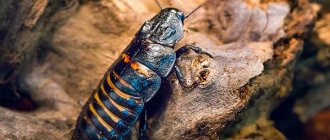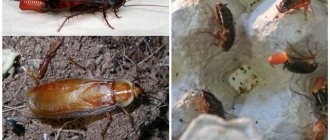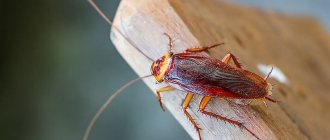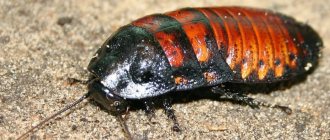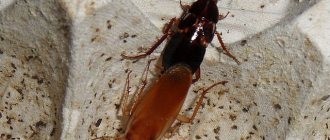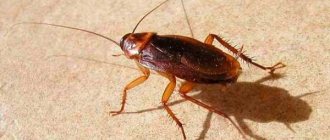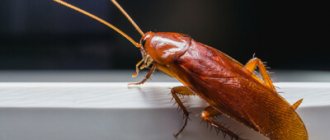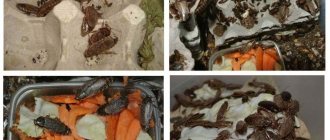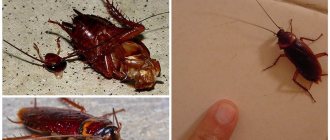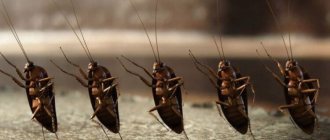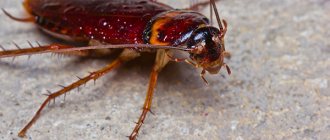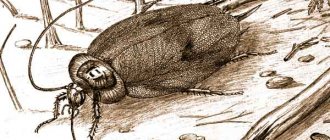Exotic lovers often have unusual animals at home, for example, Madagascar cockroaches. These representatives of the class of insects attract owners with their behavioral characteristics, exotic appearance, as well as unpretentiousness in maintenance and care. In addition, cockroaches of this species are absolutely safe for people prone to allergies.
In the article we will look at the features of keeping Madagascar cockroaches, what conditions are suitable for them, what insects eat, how long they live and how they reproduce.
What to feed Madagascar cockroaches?
Madagascar hissing cockroaches live in the tropical forests of the island of Madagascar. Insects are unusual. They grow to gigantic sizes. The length of their bodies can be 10 cm. Many exotic lovers keep such cockroaches in home terrariums.
A certain microclimate is created for them, close to the conditions of the natural environment, and their diet is prescribed. What do natural insects eat? What should you feed them when keeping them at home?
Differences between a female and a male
For those who decide to breed this type of cockroaches, it is very important that they have females and males on hand. Let's look at how to distinguish females from males:
- In males, growths similar to horns are more pronounced.
- The abdomen of an insect consists of segments. In females, the last two are dark, while in males only the last one is black.
- The female has a wider abdomen in order to bear numerous offspring.
- The antennae of males are broken and defective, because they constantly fight with each other, but of females they are neat and intact.
What do Madagascar cockroaches eat? Their diet is not much different from that of other cockroaches. They usually eat rotting grass and fruit. At home, they are also most often fed with fruits, fish food, bread, cooked cereals, and green parts of plants.
Plant food
Natural hissing cockroaches feed primarily on plant matter. They settle in places where there is food. Individuals are common in litter of leaves and dry grass. It also serves as food for them. Insects eat grass if they hide in it.
Individuals that have found shelter under the roots of bushes or trees eat wood or young shoots. Cockroaches are omnivorous. It is difficult to imagine conditions in which they would not find food for themselves. The gastrointestinal tract of insects is capable of breaking down and assimilating even cellulose.
You need to know what to feed Madagascar cockroaches if you plan to keep them at home. It must be said right away that they do not require a lot of food, but it should be varied.
Experienced keepers recommend asking breeders what they fed their pets before transporting them to their homes.
If there is no such information, then insects are offered 2-3 products. Based on the amount of food eaten, they determine what kind of food they prefer, including hissing cockroaches. What do exotic pets eat:
- vegetables: Chinese cabbage leaves, cauliflower, broccoli, peppers, zucchini; carrots, pumpkin;
- fruits: sweet apples, pears, oranges, tangerines, kiwis, peaches, apricots;
- berries: grapes, strawberries, raspberries, currants, cranberries, blueberries; dates;
- greens from the garden: lettuce, dill, celery, basil;
- natural greens: nettles, dandelions along with leaves and flowers; plantain, shepherd's purse, clover;
- dry food; oat flakes, wheat flakes, buckwheat, homemade crackers, without seasoning.
After molting
A nymph without a shell is very vulnerable. It should not be picked up. It is recommended to take photos of your pet from a terrarium. The metamorphoses that the insect undergoes took a lot of energy from it. It takes 2-3 hours to restore pigmentation and hardness of the shell.
The body, which was long, becomes flat and wide. The rest of the insects that are in the terrarium do not interfere with the rest of the molted nymph. They don't pay attention to her.
In order for the strength of the new shell to be high, the shell is quickly restored, the cockroach begins to gnaw on its chitinous shell, which it has just shed.
Madagascar cockroach after molting
In this way, he replenishes his body with protein. Mineral salts and vitamins. Usually he doesn't finish it completely. The remains are picked up by other insects in the container.
After the nymph has taken on its usual appearance, it goes to the feeder. During this period, she is given protein food, gammarus for fish. Juicy vegetables and fruits are also placed in the feeder. They are a source of fiber, vitamins and mineral salts.
After mass molting of insects, the temperature and humidity in the terrarium can be reduced. Usually it is brought to room temperature.
Prohibited Products
Red cockroaches eat any food. Madagascar cockroaches are also omnivores, but some foods are contraindicated for them.
Pets will be happy to eat pizza, a hamburger, and a sweet bun, but this food causes them increased gas formation. There is a list of prohibited products for exotic cockroaches:
- spicy food; salted crackers, chips, salted shrimp, other salty and peppery foods;
- fried foods;
- baked goods: buns, fresh bread;
- confectionery;
- sweets: candies, confiture, jam;
- fatty meat and fish;
- flowers bought in a store; Don't shower your pets with rose petals.
Cockroaches will eat all these products, but this can cause mass death of pets. Spicy and peppery foods cause poisoning in pets. Sweets and baked goods will lead to indigestion. Fatty foods contribute to the development of obesity.
Keeping Madagascar cockroaches is not difficult. Many keepers talk about this. Insects are unpretentious. They are fed 2-3 times a week. The diet is changing. Do not wash food with scented products.
When washing, use baking soda. Chemicals cause poisoning in pets. Insects should receive both succulent food and protein foods of animal origin.
An alien from the island of Madagascar, the large hissing cockroach can hardly be called an average pet - no fur, no affection for the owner. But thanks to his unpretentious disposition and funny habits, he appealed to many lovers of exotic things. Owners of terrariums breed Madagascar cockroaches as food for their pets.
Madagascar cockroach at home
Large (up to 10 cm) mute cockroaches covered with brown armor leave no one indifferent - even those who are not very fond of insects watch with interest the organization of their community. Keeping Madagascar cockroaches at home has its own characteristics:
- The hissing cockroach got its name due to its ability to emit a loud hiss during clashes with relatives and mating games. The volume of this sound is comparable to the boiling of a kettle.
- When breeding for food, you will have to acquire 20-30 adult individuals. Over time, the population will inevitably begin to degenerate, and to renew it, it will be necessary to periodically inject “fresh blood” by purchasing several young mute mutes.
- Females are viviparous, at a time they are able to give birth to up to 40 larvae, which reach maturity after 9 months and become indistinguishable from adult relatives.
- Conditions in the insectarium should be close to tropical: high humidity (minimum 65%) and temperature +30°C. At +20°C, the vital processes of mustachioed pets slow down significantly and they stop reproducing.
- You can feed cockroaches once every 3-4 days, and you need free access to water.
What do Madagascar cockroaches eat?
When it comes to feeding, the Madagascar cockroach is not picky and readily eats both animal and plant foods, but it is important to monitor the balance of nutrients. Calcium-containing foods must be present in the diet, otherwise cockroaches will begin to gnaw each other's shells. Food should be fresh and without added spices. An approximate list of what to feed Madagascar cockroaches at home:
- dry food (dog or cat);
- vegetables;
- fruits;
- greenery;
- eggshell;
- fish;
- meat;
- dairy products;
- grated crackers;
- crayfish.
How long do Madagascar cockroaches live?
The lifespan of Madagascars in the wild rarely exceeds 2 years. How long Madagascar cockroaches live at home is largely determined by the balance of their diet and the ability to create suitable conditions for them. If everything is done correctly, the life expectancy of pets increases by one and a half to two and a half times, already amounting to from 3 to 5 years.
Names for Madagascar cockroaches
To many, the idea of giving insects names will seem strange. But the large Madagascar cockroach has such a strong personality that it is simply impossible to leave it without a name. Several world zoos even held a campaign inviting visitors to give the Madagascars they house the names of their loved ones. Those who are not inclined to such radical actions can call their pet by any strict name, for example, Havard, Robert, Edward for males, and Edna, Margot, Tara for females.
Mealworm, or Great mealworm (lat. Tenebrio molitor)
Due to the ease of breeding, they were the very first to appear to me. Collecting information was not difficult, and at first the worms settled in a simple container. The result was not bad: even in relatively spartan conditions, they multiplied stably.
But over time, some rules for their more productive maintenance appeared: The container must be flat; The main thing is width, not height.
These insects cannot crawl along the walls of a container in any way, and therefore this particular box shape is optimal for them. A hole should be made in the lid of the container itself and a mosquito net should be attached.
Option for attaching a mosquito net to a container.
Filler
At the beginning of their keeping they had flour and oatmeal sprinkled in, but then it turned out that the mealworm lifestyle is a little more complex than simply burying itself in the ground, and subsequently several fillers were used. Priority is still given to flour of various types - rye, wheat, coarse - it occupies about 50% of the litter. Next comes oatmeal, old muesli is also used (optional). Then the main components are sawdust and coconut substrate. This is a great addition to add looseness and interesting texture to the adult beetles. You can also add corn filler. Moreover, beetles are excellent eaters of litter components, so if you forget to feed them, nothing bad will happen; they will successfully eat the sawdust.
There is an opinion that levels of paper should be made in the container, since the life cycle of the beetle includes an adult beetle that lives on the surface, a larva (the mealworm itself) that crawls everywhere, and a pupa that pupates in the lower layers. To create them, newspapers and magazine paper are used. However, in the case when the levels are created by kitchen napkins, the latter are quickly eaten, leaving only the top layer. It can be used to “harvest” worms. Khrushchak likes to sit just under large flat sheets. This can be a dried piece of peel, which will certainly remain if you put fruit on the worms, or a piece of napkin under which they stuff themselves. And by lifting it, you can immediately get several worms, eliminating the need to dig through the filler to find a treat for the birds.
The filler does not become dirty for a very long time, so you can change it from time to time.
Uneaten pieces of fruits and vegetables, as well as skins that insects do not eat, also become filler.
Humidity and light
Insects do not require high humidity and live under normal room conditions. But it is advisable to place the container where there is no direct sunlight.
Feeding
In addition to the fact that the beetles themselves live in their own food, they should be specially fed with juicy food. You can give pieces of fruits and vegetables, yesterday's food of insectivorous birds. It is imperative to give protein foods such as meat, fish, gammarus, and daphnia. Worms do not eat too much, and you can feed them as much as possible, without a special schedule. They also eat dead beetles and moult skins. It is better to spread the food over the entire surface of the container so that everyone gets it.
They also put in sepia and mineral stone, which they eat with pleasure.
Sepia (cuttlefish shell) chewed by a mealworm.
There is no need to install additional drinkers or water tanks.
To easily get a large amount of flour at a time, it is best to wait until they are collected under a piece of food
As a food item, these are wonderful insects: they are easy to keep and easy to breed. Birds eat such insects at any stage of their development.
Description
The homeland of these insects is the island of Madagascar. They are not found in other regions of the Earth, except that they can get there by accident in boxes of tropical fruits. In their natural environment they live in rotting leaf litter and rotten logs. This is a whole class, there are about 20 species.
It is used by insects in times of danger as a way of protecting themselves from predators, when courting a female and during fights with other males. In an insect colony, a clear hierarchy is established among the males.
Is it worth getting such a pet?
Whether to keep a Madagascar cockroach in the house or not is a rhetorical question.
If a hobby doesn’t bother others, then why not. However, it is worth thinking before getting such an original pet, weighing the pros and cons.
Everyone is in favor
The Madagascar hissing cockroach will not cause much trouble at home. Keeping it is easier than, say, fish in an aquarium or canaries in a cage.
- they do not fly, unlike other types of cockroaches;
- do not emit an unpleasant odor;
- it’s easy to hide a tray with insects so as not to shock guests;
- they reproduce easily, which is important if insects are bred to feed the inhabitants of a home terrarium - snakes, iguanas;
- do not get dirty in the house;
- they do not bite and cannot harm a person;
- You can sell quality specimens to cockroach race organizers.
Holiday organizing agencies in Ukraine offer such an attraction; this is a new type of business.
While it is not very widespread, it is not cheap, and therefore consumers are people with above-average incomes. This entertainment is often arranged for guests of corporate events.
With this attribute, in particular, the day of March 8 is celebrated, because the running season is precisely this spring month; in winter, insects are not active enough.
There are many countries in the world where cockroach racing is a common form of entertainment for the lower classes of the population, and this will not necessarily be a Madagascar.
In addition to those listed above, there are 2 more types of use of cockroaches:
- for food;
- like living decoration in the form of necklaces.
Everyone is against
There are no specific contraindications. But if there are family members in the house for whom the proximity to these insects does not bring pleasure, to put it mildly, then the answer is unequivocal - no. In addition, pet cockroaches have been proven to cause asthma.
Whether this applies to Madagascans is unknown. But to avoid troubles, if there are people with allergies in the house, it is better to avoid keeping Madagascar cockroaches.
Enemies among insects
At home, representatives of the spider kingdom willingly feed on Prussians. The spider weaves a web in the corner and patiently waits for prey. A whiskered insect entangled in a net is quite suitable for feeding. The spider injects poison and acid into the victim, due to which all the insides of the victim are digested in advance, and it draws out the contents of the body of the unfortunate insect. Loves marbled cockroaches and tarantula spiders. This is a large tarantula that some hobbyists keep as a pet. The tarantula does not weave webs; it lies in wait for its prey from ambush.
In nature, the main enemy of the cockroach family is emerald wasps. The wasp eats only an immobilized insect, having previously injected poison into it. The body of the longhorned beetle is used to lay larvae inside. The wasp paralyzes the victim, drags it into its burrow and lays larvae inside. She closes the entrance to the “house” so that the barbel does not get out. The larvae form for about a week, eating the body from the inside, then pupate and after a few more days emerge into the light.
The ants do not disdain the dead Prussian, dragging the carcass into the anthill to be devoured by the larvae. Young mantises also feed on cockroaches. They turn their heads 180 degrees in search of prey. When the victim is targeted, the praying mantis waits for it, hiding in ambush. Due to the speed of movement of the praying mantis, the cockroach has no chance to escape. Crickets do not disdain barbels either.
The centipede or house flycatcher is a carnivorous predator that eats all pests in a row: flies, ants, cockroaches, fleas, bedbugs. This is an arthropod that can handle even small lizards and frogs. When attacking, she is helped by her jaws, into which the ducts of the poisonous glands emerge. It paralyzes the victim and then slowly eats it.
Over the millennia of its existence, barbels have “made” many enemies. They have found their place in the food chain and serve as a source of food for many organisms. But at home, not everyone decides to get a lizard or a rat so that it eats the Prussians. It is more convenient for humans to use chemical, more effective methods of combating the parasite.
We create conditions in the house
In order for the exotic hobby to bear fruit and achieve its goal, Madagascar cockroaches are kept in conditions as close as possible to natural ones.
Choosing a terrarium
Terrarium - plastic tray. Buying it is not a problem; they are sold anywhere.
The size must be selected based on the purpose for which the insects are kept. If it’s for fun, then it’s small; if it’s a business project, then it depends on the scale.
Home climate
Since Madagascar is a tropical island, the conditions in the terrarium must be maintained similar. The temperature should be within +25. +30 °C. Insects tolerate decreases and increases in temperature normally; they do not die, but do not reproduce.
In addition, the humidity must also be kept high, as in the tropics. This is easily achieved by spraying. It’s important not to overdo it here. Excessive moisture leads to rotting of the litter, mold multiplies, and this is unacceptable.
Arrangement
Litter is a necessary condition for the existence of Madagascar cockroaches in a terrarium.
The materials used for it are:
- sawdust (except coniferous);
- coconut dust;
- a mixture of sawdust and sand.
The substrate is changed once a month to prevent the proliferation of mites, frequent companions of these exotic insects. Previously it was believed that this unique species of blood-sucking parasites simply drinks blood, as it should.
But further research showed that the mites, which no longer live with anyone, feed on the same things as cockroaches, and use their hosts as transport.
The decor can be arranged, or not. It all depends on the tastes and goals of the owner.
We equip an insectarium
In order for the Madagascar cockroach to be comfortable at home, it is necessary to equip it with an insectarium (special terrarium). An aquarium is quite suitable as an insectarium. The insectarium should be selected depending on the number and size of the inhabitants. About one liter per large individual.
It is also important to create conditions in the insectarium that are as close to natural as possible. You can use different options as bedding: leaves and sand, or sawdust and paper. You can combine fillers, for example, mix sawdust with leaves or paper. The layer of litter should be about two centimeters. The filler needs to be changed regularly, 1-2 times a month.
What to feed cockroaches
There are no problems here. By analogy with domestic ones, it is not difficult to conclude what to feed Madagascar cockroaches. They eat everything they eat in the kitchen.
Using leftovers from the master's table is a common practice, which makes their upkeep much easier.
All sorts of cereals, pieces of bread, boiled potatoes - everything will go into use. Insects also love variety.
Features of reproduction
It is important to know how long Madagascar cockroaches live. This allows you to determine whether the conditions are good enough.
Under natural conditions, hissing birds live only 1-1.5 years, but in captivity one individual should live for about 3 years.
Some centenarians live up to 5-6 years. This is due to the absence of natural enemies.
The breeding cycle is as follows:
- Madagascar hissing cockroaches are a viviparous species.
- The ootheca is a special chamber inside the female's abdomen where fertilized eggs are located. From time to time, the mother pushes it out of the anus to allow the larvae to breathe. It has a light appearance, long shape, seems soft.
- The eggs mature in 50 to 70 days. The timing depends on the temperature in the terrarium. It should be no lower than +18 °C and no higher than +35 °C.
- The nymphs are freed from the ootheca while still in the female’s body and, together with its remains, come out.
- The ootheca is immediately eaten by larvae, which are several millimeters in size and have a white soft shell.
- The mother protects the larvae by hissing loudly.
- Newborn larvae, up to 25 in number, remain near the cockroach for several days, then crawl away.
- The chitinous cover of the larva does not have the ability to increase in size, so the nymph is forced to molt. She does this 6 times.
- The period of development of the larva to the adult state lasts from six months to a year, depending on the conditions of detention.
ъ
As you can see, keeping a Madagascar hissing cockroach is not difficult. And with proper organization of the process, you can also make money from this.
Where does the curiosity come from?
While a good half of the residents are looking for sophisticated methods of exterminating the Prussians who are privatizing their living space, the other wants to make Madagascar cockroaches their guests. Where did such exoticism come from?
Homeland of the extravagant insect
The homeland of the Madagascar cockroach is the island of the same name. The insect lives only there, being endemic.
On other continents, it can only be found in the terrariums of exotic lovers or accidentally migrated in containers with fruit from the island of Madagascar.
Variety of species
It is difficult to distinguish a nymph from an adult
The Madagascar cockroach is not a solitary species. This is a whole genus of these insects. There are 20 species of these creatures in nature.
An interesting fact is that this type of insect lacks wings at any stage of development. While in the rest of their relatives only the larvae are wingless. This is due to the bygone need to fly into trees. They settle in litters of fallen leaves, where they live and breed.
In Madagascar cockroaches, it is sometimes difficult to find the differences between a mature nymph and an adult.
Endemic insects
Curious how long Madagascar cockroaches live?
It is surprising that, being an endemic species of insects, that is, living only in a specific area, in their homeland they live from 1 to 2 years.
There, the nutritional base is plant food and fallen tree fruits. While in terrariums in foreign lands they can live up to 3 or even 5 years.
Appearance and biological features
Why has this insect species become popular among exotic pet lovers? This is due to the relatively low maintenance costs and distinctive appearance.
Advantages in appearance
The size of an adult is up to 9 cm
The insect has a chitinous shield at the top of the thoracic region, as well as a wide and very thick abdomen. However, the main characteristic feature of these entities is their size (up to 9 cm).
The photo shows the size of the exotic insect in comparison with the palm of a person.
The color of the abdomen varies from pale red to dark brown, almost black. Typically the nymph is darker in color than the adult cockroach. Moreover, she has a stronger physique.
Males differ from females in the outgrowths located on the chest shell. However, not all species of this insect have such outgrowths. In this case, gender can be recognized by other characteristics:
- the male's mustache is often broken and not entirely straight, because he actively uses it in the fight for the female;
- the last two abdominal segments of females are black, while the last one of males is black;
- The abdomen of females is wider than that of males.
Where does the hiss come from?
Have you seen hissing cockroaches? Among the ordinary ones that we are used to seeing in apartments, there are no hissing individuals. But among Madagascans this is a common phenomenon. Animals breathe through special breathing holes located in the abdomen.
In case of danger, the body of the adult and larvae reflexively contracts, while air is forcefully released through the holes. This is where the sound comes from - a whistle.
This sound is made during the battle for the female to intimidate the opponent.
Distinctive appearance features
The Madagascar hissing cockroaches include a whole group of cockroaches whose habitat is Madagascar. This island is their natural homeland; in other countries they live only in the cages of lovers of exotic creatures, sometimes they are brought in boxes of bananas.
In total, entomological specialists identify 20 species of such cockroaches, but they have not been able to definitively determine the groups and characteristics for differentiation.
The most typical distinguishing features of insects include: a dense body on which there are no wings (they are absent in both small and adult individuals). In many other cockroaches, mature representatives of the species have wings (only the larvae may not have them), and some species have even adapted well to flying.
The breeders and owners of “Madagascars” themselves claim that nymphs in the last stages of development are very similar to adult individuals, sometimes it is not even possible to distinguish them.
As for the appearance of insects, it is quite recognizable: cockroaches have a massive and wide body, and there is a pronounced chitinous shield on their cephalothorax. The size of adult Magascars can be quite impressive - some individuals reach even 9 cm in length. If a person takes his inhabitant in the palm of his hand, he will occupy it almost completely.
The color of the outer shell of cockroaches is not uniform. The abdomen can be light red, rich rusty, brown or even almost black. More often, adult insects are distinguished by a darker color and a dense body. The appearance of the larva is strikingly different: the chitinous shell is light, the relief is clearly visible.
Adult Madagascar cockroaches have one specific physiological feature: small outgrowths located on top of the chest plate, similar to small horns. They are present only in male cockroaches; thanks to these processes, in some species it is possible to determine males or females. In females, the head is flatter, almost merging with the rest of the body.
However, there are varieties of Madagascar hissing cockroaches in which the males do not have very prominent projections on their heads. In this case, it is not possible to determine where the female is and where the male is. If separation is necessary, they are guided by other signs:
- what condition are the whiskers in: in male cockroaches they are usually damaged (broken), since individuals use them when they try to defend their right to a female over competitors. Females do not participate in such battles, so their mustaches are smooth, beautiful and intact;
- along the two extreme sections of the abdomen: in males the very edge of the body is black, while in females the last 2 segments are usually dark. In addition, due to the reproductive function, the abdomen of females is slightly wider. If you put two cockroaches of different sexes next to each other, the differences will be very clearly visible.
It is noteworthy that sex determination is only appropriate for imagoes. Nymphs do not have obvious characteristics by which individuals could be differentiated. Despite the fact that almost sexually mature individuals resemble adults, their cephalothorax is not yet so well developed.
Subtleties of content
Keeping Madagascar cockroaches is not very difficult or troublesome. They do not crap in the home, do not have a characteristic odor, do not harm human health, are quite calm, and lead a lazy lifestyle.
Easily reproduced in captivity
What you need to know
Those people who want to become the owner of an exotic animal are interested in the question: what special requirements do Madagascar cockroaches need, what is the content and nutritional base of insects? Before purchasing this creature, you need to have information about their lifestyle.
Gestation, reproduction
The female cockroach is a very caring mother. Pregnant, she does not lay eggs, but carries them constantly in the so-called genital pouch. There are about 30-40 eggs in one ootheca (cocoon).
Nymphs are always close to the female
From time to time, the female either protrudes or hides the ootheca, regulating the temperature. Larvae (nymphs) hatch after 3 months. The nymphs are translucent, only their black eyes stand out. However, after 2-3 hours they become dark brown. Nymphs eat the ootheca and the remains of their shell. After 6-10 months, the larvae turn into adults, going through 6-8 molts. The mother does not leave them, gathering them around her and protecting them from danger. However, many do not live to reach adulthood . Only 80-85% of those who survived are suitable for further breeding.
